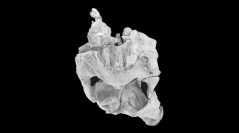

 Comptes Rendus Palevol
8 (6) - Pages 559-572
Comptes Rendus Palevol
8 (6) - Pages 559-572A new hadrosaurid dinosaur, Arenysaurus ardevoli gen. et sp. nov., from the Late Maastrichtian of Aren (Huesca, South-central Pyrenees) is described on the basis of a partial, articulated skull, mandibular remains and postcranial elements, including vertebrae, girdle and limb bones. Arenysaurus is characterized by having a very prominent frontal dome; nearly vertical prequadratic (squamosal) and jugal (postorbital) processes, and deltopectoral crest of the humerus oriented anteriorly. Moreover, it possesses a unique combination of characters: short frontal (length/width approximately 0.5); midline ridge of parietal at level of the postorbital-squamosal bar; parietal excluded from the occiput; squamosal low above the cotyloid cavity. A phylogenetical analysis indicates that Arenysaurus is a rather basal member of Lambeosaurinae and the sister-taxon to Amurosaurus and the Corythosaurini-Parasaurolophini clade. The phylogenetic and biogeographical relationships of Arenysaurus and other lambeosaurines suggest a palaeogeographical connection between Asia and Europe during the Late Cretaceous.
Hadrosauridae, Arenysaurus ardevoli nov. gen. et sp., Maastrichtian, Huesca, Iberian Peninsula